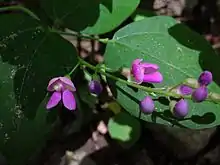Phaseolus polystachios
Phaseolus polystachios, also known as the thicket bean or wild kidney bean, is a perennial, herbaceous vine that is native to North America.[1][2] It is unique among the Phaseolus in that its native range extends across the eastern temperate United States to southeast Canada, while most Phaseolus are tropical or subtropical.[1] It is the namesake for the Polystachios group clade, which is the most species-rich within Phaseolus (17 species).[3] In spite of its common name, it is more closely related to the lima bean (Phaseolus lunatus), and it holds potential as a crop wild relative due to its resistance to white mold (Sclerotinia sclerotiorum).[4]
| Phaseolus polystachios | |
|---|---|
 | |
| Scientific classification | |
| Kingdom: | Plantae |
| Clade: | Tracheophytes |
| Clade: | Angiosperms |
| Clade: | Eudicots |
| Clade: | Rosids |
| Order: | Fabales |
| Family: | Fabaceae |
| Genus: | Phaseolus |
| Species: | P. polystachios |
| Binomial name | |
| Phaseolus polystachios (L.) Britton, Sterns & Poggenb. | |
| Synonyms | |
| |

Subordinate taxa
Subordinate taxa include Phaseolus polystachios var. polystachios, Phaseolus polystachios var. sinuatus, and Phaseolus polystachios var. smilacifolius.[1][5] The Phaseolus polystachios var. polystachios variety is listed as a special concern species and believed extirpated in Connecticut.[6]
Ethnobotany and uses
Phaseolus polystachios has been found in a few Native American archaeological sites in Oklahoma and Arkansas, with some evidence of artificial selection for indehiscent (non-shattering) pods.[7] Its fruit and seeds can reportedly be eaten in much the same way as cultivated Phaseolus, although they are smaller.[7]
Life history
Phaseolus polystachios exhibits hypogeal germination and is photoperiod sensitive, requiring day lengths greater than 10 hours to vine and flower.[8][9] It overwinters via a tuberous root system.[8][9]
Ecology
Phaseolus polystachios inhabits well-drained soils and slopes, generally woodlands and thickets, and may form colonies.[9] Their pods are eaten extensively by weevils.[4][9]
References
- "Plants Profile for Phaseolus polystachios (Thicket bean)". plants.usda.gov. Retrieved 12 December 2017.
- "Phaseolus polystachios (Thicket Bean, Wild Kidneybean, Wild Kidney Bean)". IUCN Red List of Threatened Species. Retrieved 2018-06-23.
- Delgado-Salinas, Alfonso; Bibler, Ryan; Lavin, Matt (2006-10-01). "Phylogeny of the Genus Phaseolus (Leguminosae): A Recent Diversification in an Ancient Landscape". Systematic Botany. 31 (4): 779–791. doi:10.1600/036364406779695960. ISSN 0363-6445.
- "The Quest for the Wild Kidney Bean - The Plant Press". nmnh.typepad.com. Retrieved 2018-06-23.
- "Tropicos | Name - Phaseolus polystachios subsp. smilacifolius (Pollard) Freytag". www.tropicos.org. Retrieved 2018-06-23.
- "Connecticut's Endangered, Threatened and Special Concern Species 2015". State of Connecticut Department of Energy and Environmental Protection Bureau of Natural Resources. Retrieved 2 January 2017. (Note: This list is newer than the one used by plants.usda.gov and is more up-to-date.)
- "Phaseolus polystachios (L.) BSP. - Wild Bean | Paleoethnobotany Laboratory Guide". pages.wustl.edu. Retrieved 2018-06-23.
- Allard, H.A. (1943). "The probable relationship of Phaseolus polystachios to other species". Rhodora. 45: 169–170.
- Allard, H. A. (1947). "The ecology of the wild kidney bean Phaseolus polystachios (L.) BSP". Journal of the Washington Academy of Sciences. 37 (9): 306–309. JSTOR 24531921.